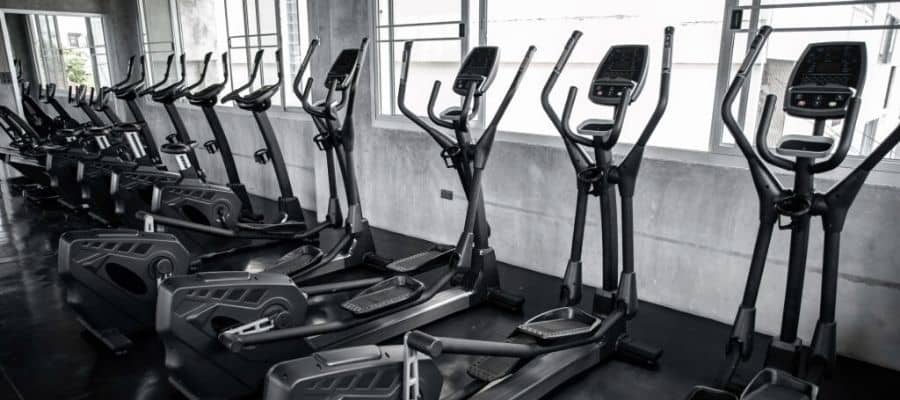
Searching for elliptical benefits and drawbacks online? Do you want to find out if elliptical trainers pose any health risks? Or maybe you’re just curious as to what this unusual equipment is for.
Elliptical machines are designed to mimic the motion of running while causing minimal strain on your joints. They can provide you with an excellent calorie-burning exercise session.
So how Does an Elliptical Work?
Both of your feet remain firmly in place on the footholds. When you walk or run, you complete a gliding action rather than an impact with your foot hitting the ground as you would when jumping.
Several ellipticals come equipped with handles. When you use an elliptical machine, you get a full-body exercise by moving your arms and legs at the same time. Different muscle areas can be targeted by pedaling in the opposite direction.
Benefits of An Elliptical Machine
1. Burns a Lot of Calories
Jump on the elliptical if you’re looking for a quick approach to burn calories. This aerobic equipment may burn between 270 and 400 calories in 30 minutes, depending on your weight.
A person weighing 125 pounds (56.7 kg) falls at the low end of the weight spectrum, while a person weighing 185 pounds falls at the high end (83.9 kg).
Losing weight can be aided by burning more calories than you consume. Consider raising the intensity of your elliptical workouts in order to burn more calories.
2. Boost Stamina
A well-rounded workout should include both aerobic and cardiac training. The heart and lungs work harder to supply your muscles with more blood and oxygen when you conduct aerobic activity.
You can strengthen your heart, lungs, and muscles while using an elliptical machine. As a result, your stamina and endurance will improve.
High-intensity interval training (HIIT) and steady-state cardiac training (SSM) are both possible on an elliptical machine.
3. Upper and Lower Body Workout
One of the few cardio equipment that can give you both an upper and lower body exercise is an elliptical machine with handlebars.
Maintaining a consistent weight and resistance distribution is critical to getting the most out of this exercise for your upper body. To put it another way, pump your arms at the same rate as you move your legs.
When used properly, the elliptical can help you strengthen your glutes, hamstrings, quadriceps, chest, back, forearms, triceps, and core muscles.
3. Less Stress on Your Joints
Elliptical machines were welcomed into the fitness industry in the 1995 by runners with aching joints and overuse issues because they allowed them to exercise their cardiovascular system while reducing some of the strain on their joints.
When you run or engage in other high-impact cardio exercises, your knees, ankles, hips, and other joints are put under a lot of strain. An elliptical provides a low-impact cardio workout because your feet never leave the pedals.
Research shows that elliptical workouts are less weight-bearing than running, jogging, and other cardio routines.
An elliptical allows you to continue exercising without the physical strain that comes with high-impact workouts.
5. Burns Body Fat
Compared to other cardio machines like the stationary cycle, the elliptical burns more calories and can speed up the process of fat loss. If you do a lot of interval training, this is especially true.
To get the most out of your workouts, focus on increasing the intensity and length of your sessions. It was discovered in one study that while both high and medium intensity workouts helped people lose weight, high intensity interval training allowed you to accomplish more in less time.
Think about including 2-to-1 interval training into your elliptical workouts: 30 seconds of high intensity activity, 15 seconds of recovery.
During your healing time, don’t let up on the movement in your legs. Keep moving the pedals, but at a slower speed.
6. Improved Balance
You can increase your balance and bone strength by engaging in weight-bearing exercise. By standing up straight and releasing the elliptical handles, you will strengthen your core muscles while also improving your balance.
Just make sure that the elliptical machine’s resistance and slope are set to a level that allows you to safely ride it without the need of handles.
7. Fitness After Injury
If you’re recovering from an injury and unable to engage in your usual physical activities, using an elliptical trainer can help you get back in shape.
Compared to high impact exercises like running, the elliptical has less impact on your joints.
If you’ve been injured, an elliptical workout may help you restore full mobility. As a bonus, it can aid in the strengthening of your muscles and joints while relieving stress from the effected area.
8. Ease of Use
One of the benefits of using an elliptical machine is that it takes very little time to become familiar with it. The learning curve for this machine is rather low, but if you have never used one before, you may want to seek the advice of a personal trainer.
For guidance on how to use it properly and what style of training is most appropriate for your specific fitness objectives, consult with an expert trainer.
When you initially start out on the elliptical, you may want to stick to just the foot pedals to get the hang of things. Add the handles once you’ve mastered the machine’s movement.
Disadvantages of Elliptical Trainers
Exercise machines such as ellipticals have numerous advantages, but they are not suitable for everyone and may not be the most efficient way to get your daily exercise.
1. No Muscle- and Bone-Strengthening Effect
Despite the fact that elliptical machines are great for cardiovascular health, the low-impact training they give is ineffective for building muscle. Weight-bearing workouts help strengthen bones, but a low-impact workout does not. In order to strengthen your muscles and bones, you may want to incorporate some additional exercises into your routine. If you’re a member of a demographic that need low-impact workouts, make an appointment with your physician first.
2. Calorie Comparison
Elliptical trainers can burn roughly 335 calories in 30 minutes for a 155-pound person. However, other activities, such as high-impact step aerobics, intense cycling on a stationary bike, and running at a rate of 5 mph or faster, will help you burn more calories.
3. Knee Problems
For some people, elliptical trainers aren’t the best option. If you have a knee problem or injury, an elliptical machine may cause knee pain. In this case, you might be better off with an exercise bike or a different type of physical activity that a doctor or fitness expert recommends for you to do. A treadmill running can better prepare your body for running motions than the elliptical machine if you’re training for a marathon.
Final Words
Elliptical trainers have several advantages despite some drawbacks. They provide a cardiovascular workout comparable to that provided by a treadmill, which can improve your health and aid in weight loss Low-impact exercise on the elliptical machine is good for your legs and back. Additional features included on many elliptical machines include pedaling backward to target the calves and hamstrings as well as handles to assist you in strengthening your arms.
Read Next:
